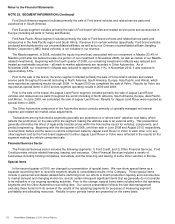Ford 2010 Annual Report Download - page 180
Download and view the complete annual report
Please find page 180 of the 2010 Ford annual report below. You can navigate through the pages in the report by either clicking on the pages listed below, or by using the keyword search tool below to find specific information within the annual report.
178 Ford Motor Company | 2010 Annual Report
Employment Data
Employment Data
The approximate number of individuals employed by us and entities that we consolidated as of December 31, 2010 and 2009 was
as follows (in thousands):
2010
20102010
2010
2009*
2009*2009*
2009*
Automotive
AutomotiveAutomotive
Automotive
Ford North America ................................................................................................
................................
75 71
Ford South America................................................................................................
................................
15 15
Ford Europe................................................................................................
................................
49 49
Ford Asia Pacific Africa................................................................................................
................................
18 15
Volvo................................................................................................................................
................................
— 19
Financial Services
Financial ServicesFinancial Services
Financial Services
Ford Credit................................................................................................
................................
7 8
Total
TotalTotal
Total................................................................................................................................
................................
164 177
* Data reflect retrospective application of the accounting standard for consolidation of variable interest entities
("VIEs").
The year-over-year decrease in employment primarily reflects completion of the sale of Volvo, as well as Ford Credit global
personnel-reduction programs, offset partially by increases in North America and Asia Pacific Africa largely to support increased
production.
Substantially all of the hourly employees in our Automotive operations are represented by unions and covered by collective
bargaining agreements. In the United States, approximately 99% of these unionized hourly employees in our Automotive sector are
represented by the International Union, United Automobile, Aerospace and Agricultural Implement Workers of America ("UAW" or
"United Auto Workers"). Approximately two percent of our U.S. salaried employees are represented by unions. Most hourly employees
and many non-management salaried employees of our subsidiaries outside of the United States also are represented by unions.
We have entered into collective bargaining agreements with the UAW, and the National Automobile, Aerospace, Transportation and
General Workers Union of Canada ("CAW"). In 2007, we negotiated with the UAW a transformational agreement, enabling us to
improve our competitiveness and establishing a Voluntary Employee Benefit Association ("VEBA") trust ("UAW VEBA Trust") to fund
our retiree health care obligations. We completed prepayment in full of our obligation to the UAW VEBA Trust during 2010; see
"Liquidity and Capital Resources" in "Management's Discussion and Analysis of Financial Condition and Results of Operations" and
Note 19 of the Notes to the Financial Statements for additional discussion of the prepayment of this obligation.
In March 2009, Ford-UAW membership ratified modifications to the existing collective bargaining agreement that significantly improved
our competitiveness, saving us up to $500 million annually and bringing us near to competitive parity with the U.S. operations of foreign-
owned automakers. The operational changes affected wage and benefit provisions, productivity, job security programs, and capacity
actions, allowing us to increase manufacturing efficiency and flexibility.
On November 1, 2009, the CAW announced that a majority of its members employed by Ford Canada had voted to ratify
modifications to the terms of the existing collective bargaining agreement between Ford Canada and the CAW. The modifications are
patterned off of the modifications agreed to by the CAW for its agreements with the Canadian operations of General Motors and
Chrysler and are expected to result in annual cost savings. The agreement also confirmed the end of production at the St. Thomas
Assembly Plant in 2011.
On November 2, 2009, the UAW announced that a majority of its members employed by Ford had voted against ratification of a
tentative agreement that would have further modified the terms of the existing collective bargaining agreement between Ford and the
UAW. These latest modifications were designed to closely match the modified collective bargaining agreements between the UAW and
our domestic competitors, General Motors and Chrysler. Among the proposed modifications was a provision that would have precluded
any strike action relating to improvements in wages and benefits during the negotiation of a new collective bargaining agreement upon
expiration of the current agreement, and would have subjected disputes regarding improvements in wages and benefits to binding
arbitration, to determine competitiveness based on wages and benefits paid by other automotive manufacturers operating in the United
States.
Even with recent modifications, our agreements with the UAW and CAW provide for guaranteed wage and benefit levels for the term
of the respective agreements, and a degree of employment security, subject to certain conditions. As a practical matter, these
agreements may restrict our ability to close plants and divest businesses during the terms of the agreements. Our collective bargaining
agreement with the UAW expires on September 14, 2011; our collective bargaining agreement with the CAW expires on
September 14, 2012.


















